How to Create an Employee Handbook (+10 Examples)
- Published:
- Updated: July 2, 2024

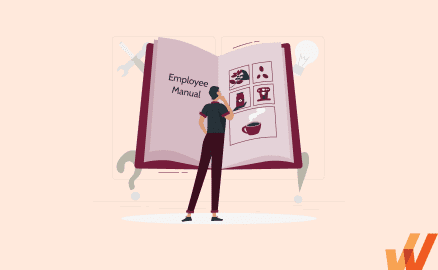
According to Gallup, only 6 in 10 U.S. employees clearly understand what is expected from them at work. That’s right – 40% of employees fail to know what their work expectations are.
One possible solution? An up-to-date, effective employee handbook.
What Is an Employee Handbook?
An employee handbook, also known as an employee manual or staff handbook, is a resource compiling policies, requirements, expectations, and procedural manuals in the workplace that guide employee actions and provide answers to common questions. It’s a perfect tool for regulating business relations and solving (and preventing) conflicts.
An employee handbook helps to transmit your company’s mission, set clear expectations for specific roles between management and employees, provides answers and guidelines for HR-related questions, and prevents legal issues. Creating and regularly updating an employee handbook is a critical part of an organization’s knowledge management process.
Without it, neither you as an employer nor the workforce will feel confident in your ability to navigate company policy and will set up organizations for failure.
What Is Included in an Employee Handbook?
There’s a ‘book’ in its name, and for good reason. The resource typically includes between 50 and 150 pages (or slides) that cover every critical aspect of the employee-organization relationship.
Employee handbooks come in different forms, from electronic documents, presentations, PDFs, physical handbooks, and more. Whatever their format may be, their content includes similar components and sections, including:
1. Introduction & Table of Contents
An introduction should be sweet and short. A message or short note supporting your company mission statement from a C-level executive is a perfect way to start out your handbook. You can see an example from CEO Marc Benioff in Salesforce’s code of conduct handbook below.
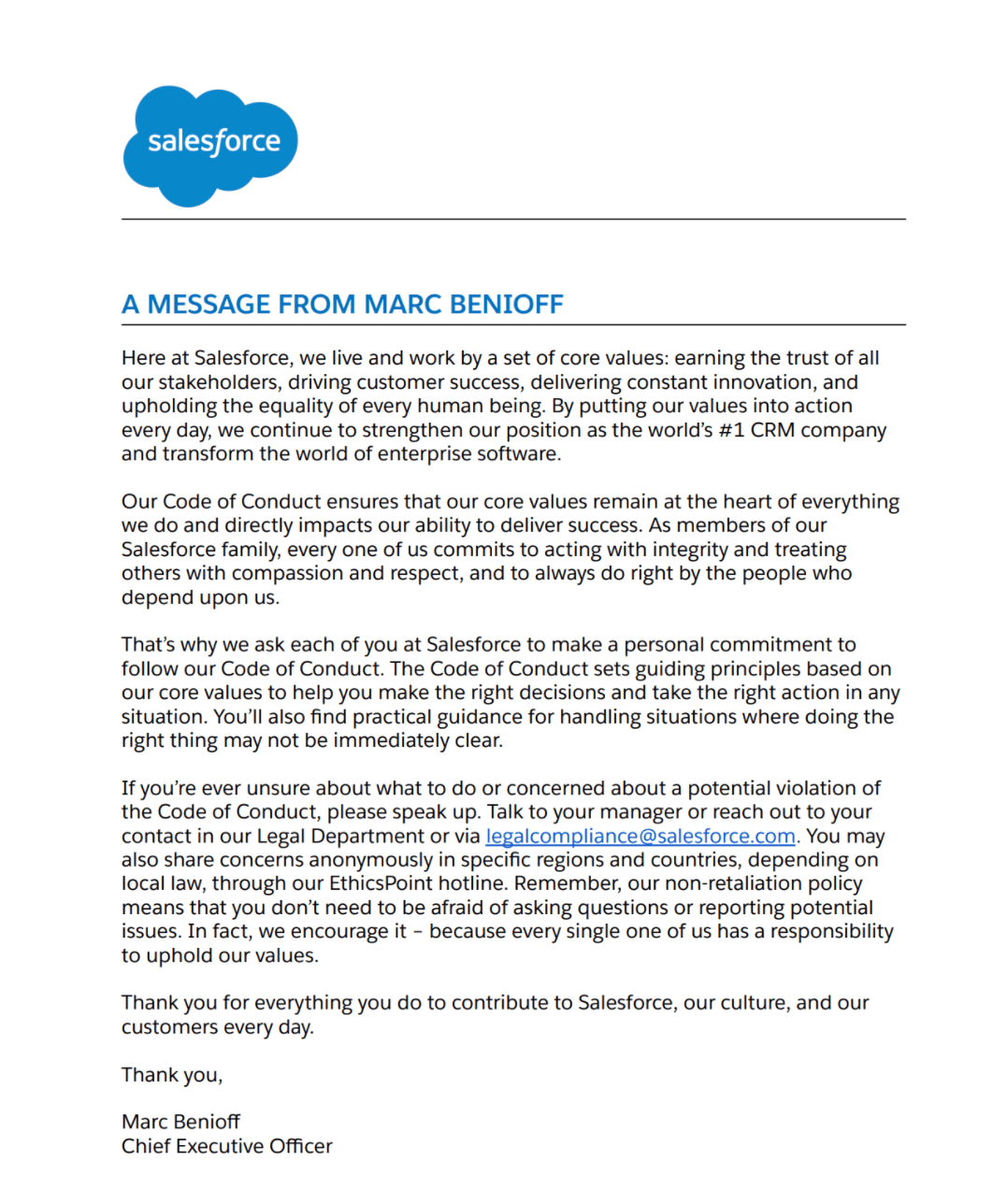
An employee handbook should also be easy to navigate. Your employees won’t read it from start to finish.
Therefore, it’s critical to include a very detailed table of contents where each section is highlighted. This allows employees to quickly find the information they’re in need at that moment.
It’s also a good idea to include the dates when certain content was updated – it allows employees to follow all the changes within your workplace policies.
Below you can see a great table of content example from Uber’s business code of conduct document.
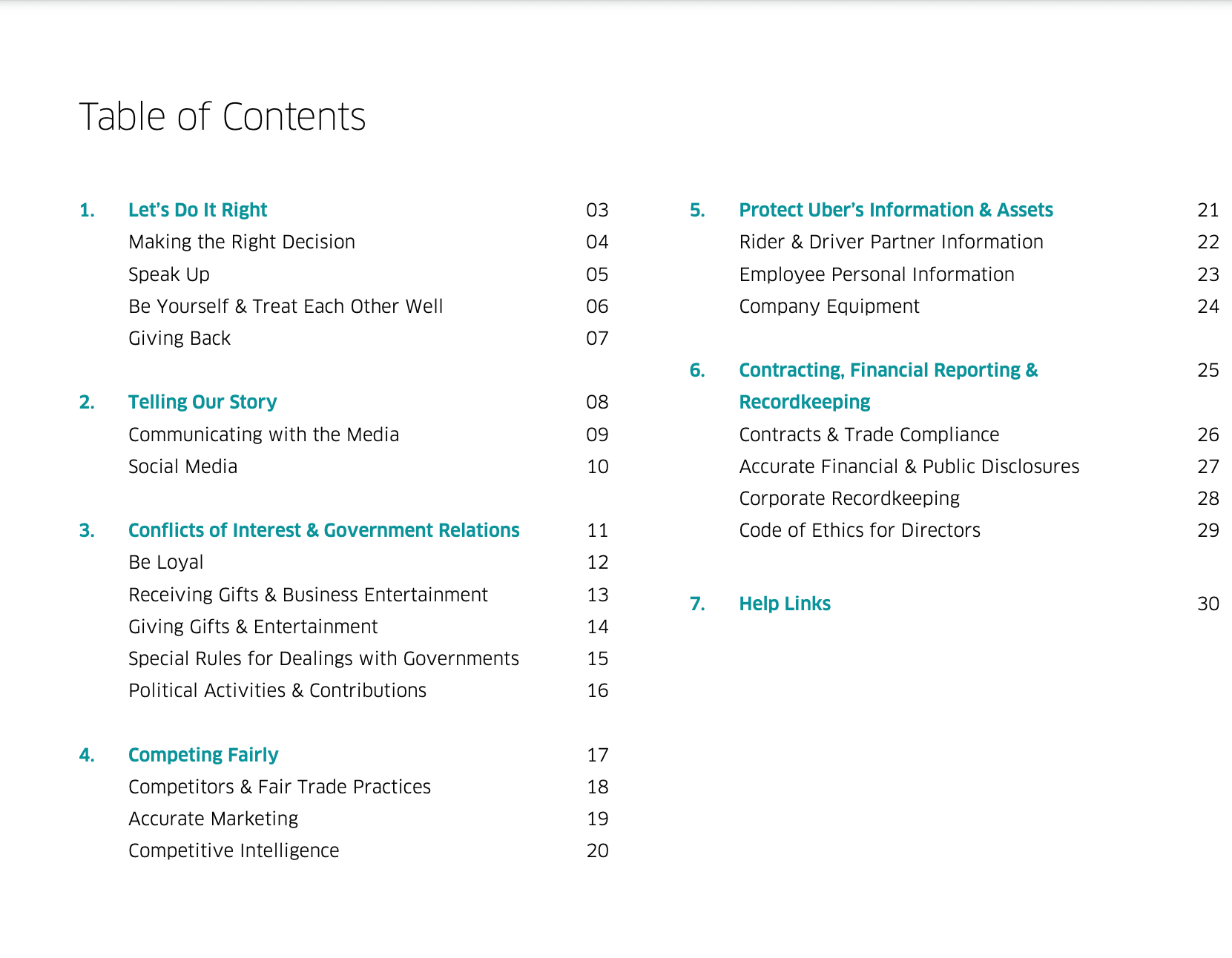
2. Legally compliant policies
No one will sue you for missing information on legal regulations in the employee handbook. It’s not a legal instrument,t but a helpful instruction.
However, to prevent your team members from unknowingly violating labor or compliance laws, it’s strongly recommended that you include various important employment laws and issues that your company or industry faces in your staff handbook.
A few obvious ones to include are:
Employee rights
While creating an employee handbook isn’t required by any law enforcement organization, you’re obliged to inform workers of their rights.
If your company is registered in the U.S., this section should comply with the major laws introduced and protected by The U.S. Department of Labor. In Europe, employee rights are protected by the European Union legislation.
Workplace policies
Workplace policies regulate standard operating procedures (SOPs) and employee behavior in the workplace. These are typically built upon laws and modified based on the company’s needs.
Your workplace policies can regulate the following aspects:
- Confidentiality and data protection
- Health and safety, including family medical leaves
- Harassment and violence
- Equal employment opportunity (EEO) and anti-discrimination
When including policies, explain them in simple terms. To prevent your employee handbook from turning into a copy of the Constitution that your employees will not read through, you can adopt policies to fit the format.
In this template built by AirMaison, you see how EEO policy statement can be modified to reflect the peculiarities of a specific company.

Location-specific sections
Each state (in the U.S.) or country (in Europe and Asia) has unique employment and labor laws, and you should consider adding an extra section when your HQs are registered in more than one location. It can also occur that there are legal reasons for writing a dedicated handbook for employees in each state if your business operates in states with completely different regulations.
Time and attendance
How do you track employee working hours? To effectively manage your workforce, you need to have a policy that regulates:
- Employee schedules;
- Shift start and end times;
- The way employee hours and wages are calculated;
- Annual leaves, vacations, sick leaves, etc.
The section should outline your expectations for employees’ work time and attendance in order to create a better environment for collaboration and productivity.
3. Code of conduct
All U.S.-based public organizations are required by law to have a code of conduct documented. While not required, private organizations also benefit from including this section in their employee handbook as well.
Similar to workplace policies, this set of rules tells employees how they should behave in the workplace. But while workplace policies mostly focus on the well-being of the workforce, a code of conduct protects the business.
The section usually starts with information on the company’s story, ethical principles, values, and mission. Next, you can outline standards for:
- Dress code;
- The use of the internet and corporate email;
- The use of social media at work;
- Representing the brand on social media;
- Preventing conflict of interest;
- Relationships at work;
- Managing non-public information, etc.
4. Employee benefits and perks
You can use your employee handbook to provide workers with an overview of benefits and perks, such as :
- Health insurance;
- Remote work policy;
- Unlimited PTO policy;
- Compensations;
- Stock offerings;
- Company laptop and technology;
- Mobile phone reimbursement policy, etc.
Don’t forget to specify who is eligible for certain benefits and whether there are any limitations. It’s good to list the criteria for eligibility, such as holding a specific role, celebrating life events, reaching milestones, etc.
5. COVID-19 regulations
The new normal is no more new. The pandemic affects all businesses, and you can’t ignore it. You need to outline policies on social distancing, staggered work schedules, vaccinations, and symptom checking to keep your workplace safe from COVID-19.
To ensure the relevance of the information provided, review guidelines provided by the Occupational Safety and Health Administration (OSHA) or The European Agency for Safety and Health at Work (EU-OSHA).
Including COVID-19-driven regulations in a handbook has certain drawbacks though. Given that the rules are updated more often than any other policy, you’ll need to keep a close eye on the news to add fresh information promptly.
6. Disclosures
Caring about your employees is crucial, but you also need to be careful with making false claims unknowingly. Make sure to conclude your employee handbook with the following disclosures:
- “This employee handbook is not a contract, and it does not guarantee employment for any specific length of time.”
- “This handbook supersedes all previous regulations. Policies mentioned in this manual are to be given priority in case of a conflict with a rule found elsewhere in the company documents.”
- “The content of this handbook may be subject to change as the company finds necessary.”
These are essential components of any employee handbook. There might be many more policies that you’ll want to include depending on your niche, business model, and location.
✓ Thank you, the template will be sent to your email
When Does a Company Need an Employee Handbook?
Remember that you don’t have to create an employee handbook. It exists for you and your employees’ convenience.
If you feel your employees don’t have problems with accessing information about their relationship with your organization, having a detailed knowledge base might be enough for you.
Nonetheless, an employee handbook has a bunch of compelling benefits for businesses and individuals:
- It introduces newcomers to your company culture, mission, and principles;
- It communicates your expectations from employees;
- It educates employees on their rights;
- It ensures higher transparency;
- It builds trust employees;
- It prevents conflicts;
- It offers ways for solving conflicts and many more.
Be sure that your employee handbook doesn’t replace essential process documentation, such as training manuals, video tutorials, or an internal wiki. These documents are helpful in different scenarios, but all of them serve one purpose – they help to streamline business processes and transfer knowledge.
9 Examples of Great Employee Handbooks in 2024
We’ve already emphasized how employee handbooks come in totally different formats. It’s time to prove the point.
Here are ten of the best employee handbook examples to use as inspiration when creating yours:
1. JetBlue
JetBlue’s handbook is a rare example of an employee handbook where all the information on company values, policies and employee benefits is presented in a way that doesn’t make readers feel overwhelmed. It’s a straightforward document that is presented in a PDF-format that can be sent digitally or that could be printed into a physical document as well.

2. Facebook
Facebook has chosen to not include a set of rules in their official handbook. This is an example of an employee handbook that just tells the story that should motivate new recruits and long-term employees.
Facebook actually prints off physical copies of their handbook (pictured here) and sends it out to all new employees, known as Facebook’s little red handbook.
What makes it great? It transmits the company’s values, introduces everyone to the context, and empowers the whole organization.

3. Toggl
Toggl’s official employee handbook isn’t available for public access, but the company displays brief handbooks that introduce prospective employees to the company culture on its website.
The manuals guide people interested in applying for jobs at Toggl through their remote work policies, core values, and manifesto – during the application process, meaning employees are able to see if Toggl is a fit for them before they apply. This resource allows the company to attract hires that share their values.

4. Starbucks
First of all, it’s worth highlighting that Starbucks refers to its employees as partners. This single practice boosts employee morale significantly.
The company’s Standards of Business Conduct regulate relationships between employees as well as customer relationships. It comes in a form of Q&A and therefore is easy to read and memorize – and is digitally available as a PDF.

5. Coca-Cola
Coca-Cola’s code of conduct is a comprehensive 41-page document – as we would expect from an enterprise company of its size. The manual guides employees through principles that should guide their decisions in the workplace.
While the document contains a lot of information, a number of charts, maps, and other visual elements help to illustrate each point and make the information more digestible.

6. HubSpot
HubSpot’s employee handbook, or Culture Code, is a 153-page presentation, which actually doesn’t look so boring as it sounds. The company shares inspiring quotes, provides guidelines for using good judgment, and what’s most importantly, ignores policies and procedures.
The large document covers everything an employee needs to know at HubSpot – while also setting the company’s culture tone.

7. Zoom
Zoom’s employee handbook starts with a message from Eric Yuan, Founder and CEO at Zoom, which is followed by a clear table of contents. It’s remarkable how different policies are grouped based on the purpose they serve.
At the bottom of the page, you can also see when the current version of the handbook has been created. It’s a clearly outlined and well-organized document that any employee could use to find answers to common HR-related questions at Zoom.

8. Twilio
Twilio is the first employee handbook example on this list that makes it easy to switch between sections in one click with a simple-to-use and intuitive user navigation feature that includes jump links to various sections. That is important too, as employee can visit any necessary section without scrolling all the way through its comprehensive 44-page document.


9. Trello
Trello has built an employee handbook template right inside their own platform – allowing it to use its handbook as a way of conducting product knowledge training with new employees and building its brand right into its core internal processes.
Each key component of an employee manual has a separate card that’s split into different sections. This employee handbook is incredibly easy to update, collaborate on, and make accessible by the entire organization.




5 Best Tools for Creating Employee Handbooks in 2023
It’s easy to make your employee handbook the most boring piece among all your process documents. If you want your employees to read it, try to keep it short and replace text with visual elements when possible.
Here are a few tools that will help you make an employee handbook for your company that is memorable, effective, and easy to read:
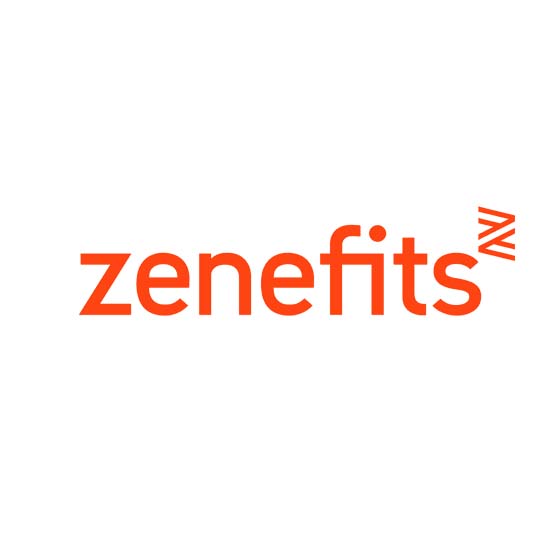

1. Workest by Zenefits
- Price: Free
- G2 Rating: 4.1 out of 5 stars
Workest is an employee handbook builder for creating very simple text-based manuals. If you don’t have wild ambitions for designing an outstanding, unique handbook, the tool is the right choice for you to create a solid, standard handbook that looks official and gets the job done.




2. Visme
Price: Free on a Basic plan
G2 Rating: 4.6 out of 5 stars
Visme is online software for creating visual brand experiences. Alongside other features, the platform offers a tool for creating employee handbooks. You can choose one of the multiple templates and customize it with your brand identity elements. It’s a great tool that provides HR teams with a suite of design features, created for non-design experts.




3. Canva
- Price: Forever free plan available
- G2 Rating: 4.7 out of 5 stars
Canva functions similar to Visme, or any other drag-and-drop graphic design platform. It also offers a variety of employee handbook templates to choose from and allows users to realize almost any creative idea. Like Visme, it provides users with a plethora of tools that help non-design professionals create stunning company handbooks.




4. Blissbook
- Price: From $62.50/month (free trial available)
- G2 Rating: 4.0 out of 5 stars
Blissbook is a dedicated tool for making employee handbooks. It not only facilitates the creation of visually appealing manuals but also offers opportunities for managing the resulting handbooks in a more effective way. It allows for communicating content changes to employees, collecting electronic signatures for compliance, tracking each policy’s version history, and more.




5. Airmason
- Price: From $83.25/month (7-day free trial available)
- G2 Rating: n/a
AirMason is another dedicated employee handbook builder on the list. It allows employers to track electronic signatures, notify employees of content updates, and receive activity reports. It also includes a wide range of templates that include handbooks designed for various industries, as well as various brand styles (such as modern, vibrant, chic, etc.)


6 Tips for Creating the Best Employee Handbook
Now that you know how a good employee handbook looks, it’s time to highlight a few actionable practices for making yours even better.
1. Create a Digital, Online Employee Handbook
What will happen to your employee handbook if you present its printed version to a new recruit on their first day? Right, they’ll put it in the drawer, and it will be buried under the pile of papers.
Your employees should be able to access it via a direct link on any device – both desktop and mobile. With an employee handbook that’s instantly accessible online, it’s easier to tackle updates and keep track of users engaging with it.
With digital employee handbooks, HR professionals can keep track of who has – and who hasn’t – reviewed mandatory company policies, compliance issues, and code of conduct updates with easy-to-use analytic features.
These features make communicating policy changes and updates easy with simple features such as in-handbook pop-ups and email alerts to let employees know when rules and policies have had changes – and what’s new since the law time they viewed their employee handbook.
Below, you can see how Airmason users can see their workforce’s employee data in a centralized reporting dashboard on how they’re engaging with their employee handbooks, company policies, and code of conduct.
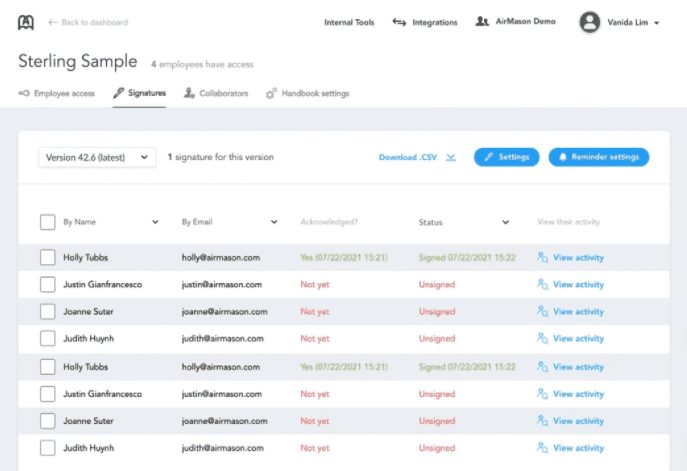

For frontline workers, you might need to provide a printed handbook though. However, you’ll need to remember to inform them of any handbook updates, which is easier when you have can connect with remote employees via online communication channels.
2. Routinely Update Your Employee Handbook
An employee handbook isn’t something you create once and never get back to it. To stay relevant for employees throughout the years – whether they join your organization in 2024 or 2040 – the manuals should be regularly revised and updated.
For instance, several states are going to adopt new paid family leave laws in 2021-2024 – the changes that should be reflected in the handbooks of hundreds of organizations. Whether they manage to effectively communicate new regulations to their employees or not will affect employee morale significantly.
By keeping your employee handbook relevant, you’ll also reduce the risk of a lawsuit. An outdated staff handbook can be harmful not only to your organization but also to the workforce.
3. Make Your Handbook Easy to Find
36% of Millennials have no idea where they can access an employee handbook. Does it mean they don’t need it? Not at all. Does it mean they aren’t aware of the benefits its content can bring them? Probably.
What is for sure is that 64% of employers fail to make their employee handbooks applicable and, most importantly, easily accessible.
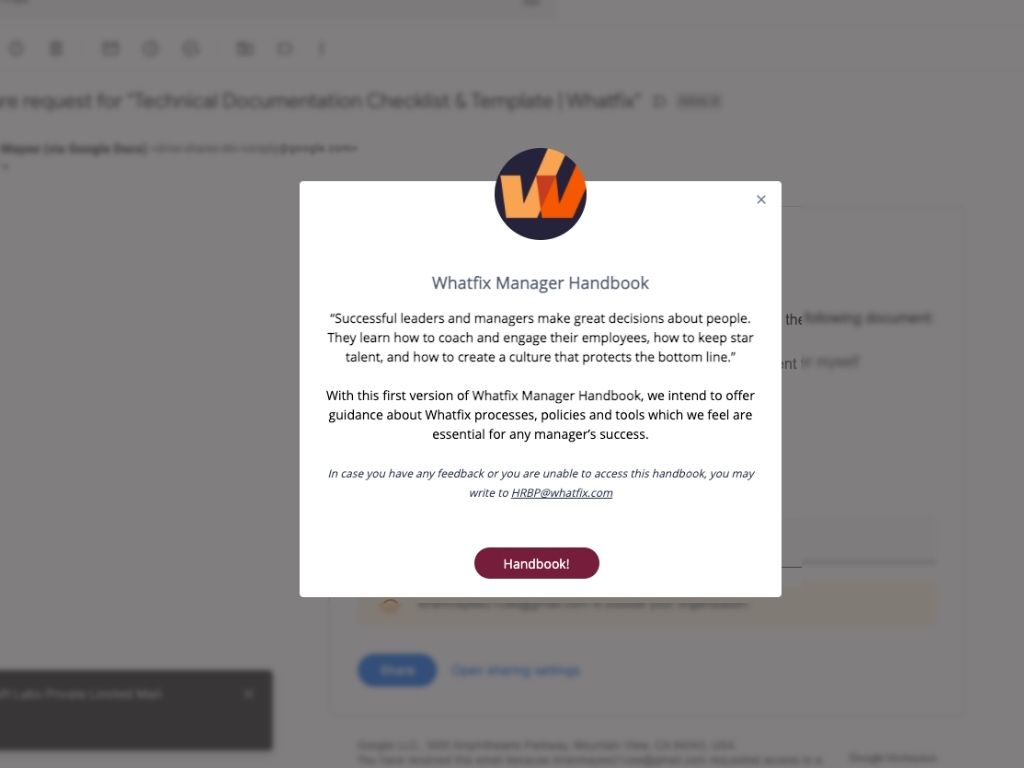

Above: With Whatfix, create pop-ups in your email, digital processes, and business apps that drive your employees to your handbook – helping to drive visibility of workplace policies and updated procedures.
If you haven’t adopted a tool for employee onboarding and managing yet, it’s the right time to do it. With a tool such as Whatfix, you’ll store all the business documentation, including an employee handbook and onboarding checklists, embedded in your workplace apps such as your email, MS Teams, CRM, HCM, and more.
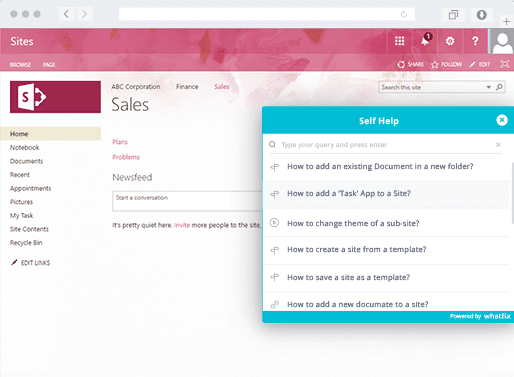

Instead of wasting precious time trying to find the necessary information, your teams will get guidance in a few clicks – all embedded in their digital tools, processes, email, and more.
4. Include a Table of Contents and Search Functionality
An employee handbook is very likely to turn into the Bermuda Triangle of policies unless you provide a table of contents and enable the search functionality.



Regardless of the format of your handbook and the channel for distribution, you need to enable its content to be searchable. To achieve a better experience, reflect any updates in the table of contents, highlight the most important issues, and consider including the FAQ section.
5. Use Visuals and Videos
You’ve just seen top companies are moving away from ridiculously long, monotonous employee handbooks. They add quality visuals and use a conversational writing style to make employee handbooks readable and engaging. It’s also getting more popular using videos in place of a letter of a C-level executive.
You can also use pop-ups in your company’s email and digital tools to promote your handbook to your employees, in the flow of work, with tools such as Whatfix (seen below.)
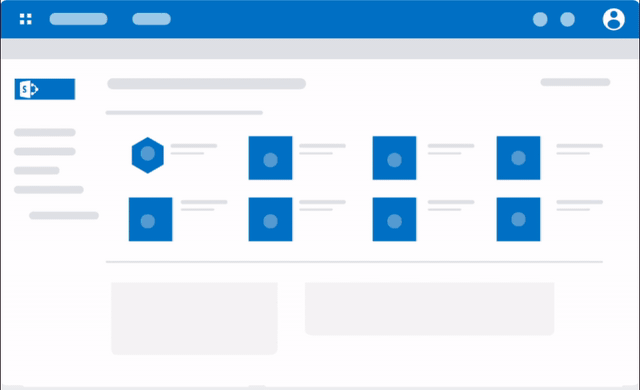

Treat your employee handbook as a way of communicating your company’s unique vision – infuse it with color and include energetic visuals that support your points.
Making an employee handbook is an important step towards developing a strong knowledge-sharing culture. Today, you not only have a wide range of tools that make the creation of handbooks easy but also have opportunities for distributing and managing them effectively.
With Whatfix, embed an on-demand self-help wiki directly into your digital processes and tools – allowing your employees to search for answers to their company policies and procedures in the moment of need.
Request a demo to see how Whatfix empowers organizations to improve end-user adoption and provide on-demand customer support


